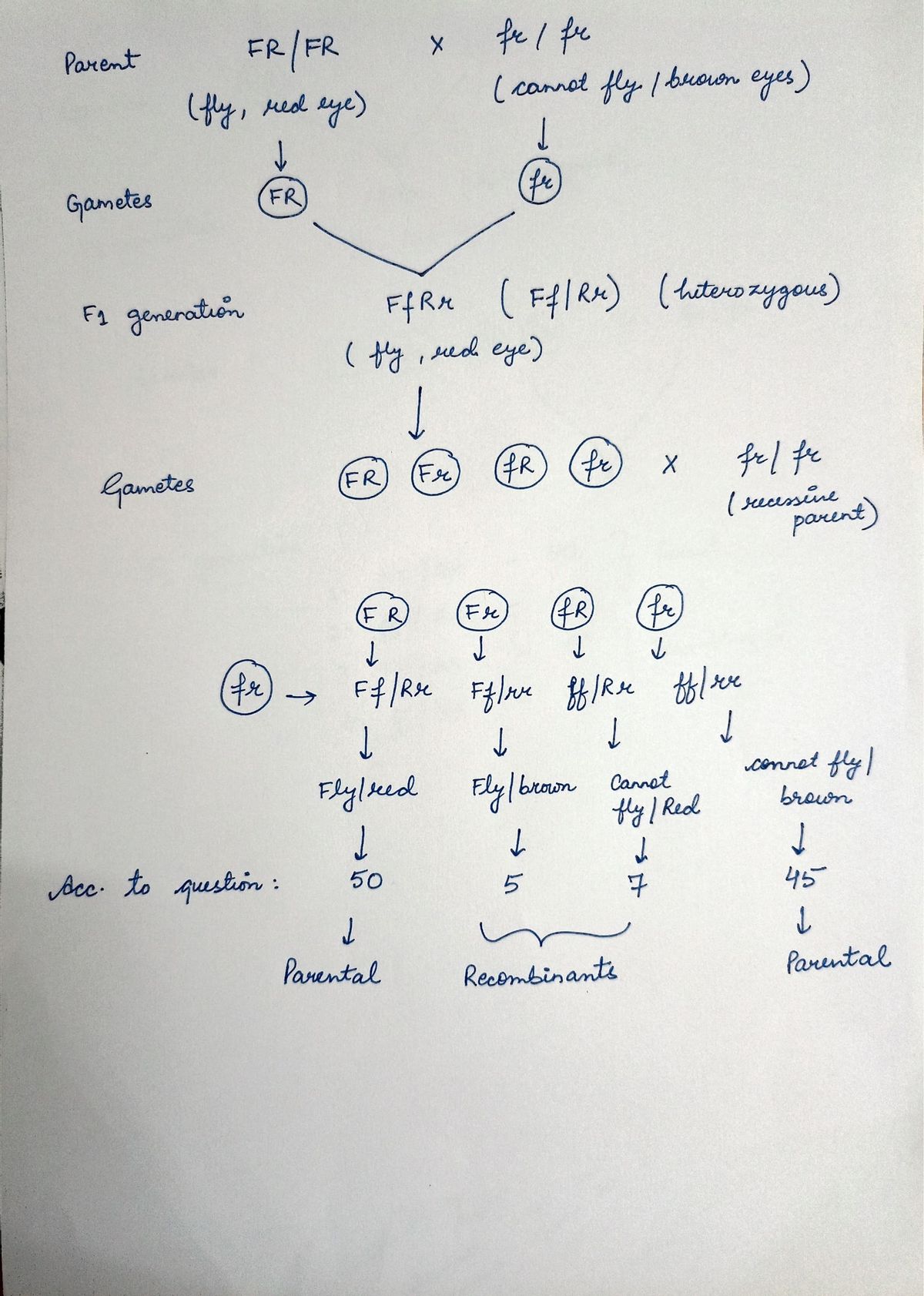Human Anatomy & Physiology (11th Edition)
11th Edition
ISBN:9780134580999
Author:Elaine N. Marieb, Katja N. Hoehn
Publisher:Elaine N. Marieb, Katja N. Hoehn
Chapter1: The Human Body: An Orientation
Section: Chapter Questions
Problem 1RQ: The correct sequence of levels forming the structural hierarchy is A. (a) organ, organ system,...
Related questions
Question
![**Drosophila Genetics: Understanding Gene Linkage and Recombination**
In Drosophila, two specific genes are located on the second chromosome:
- **Flight Gene**: The dominant allele (F) allows flight, while the recessive allele (f) results in non-flying.
- **Eye Color Gene**: The dominant allele (R) gives red eyes, whereas the recessive allele (r) gives brown eyes.
**Genetic Cross Experiment:**
1. Flies with the genotype FR/FR are crossed with flies of the fr/fr genotype.
2. The offspring from this cross are then crossed again with flies that are fr/fr.
**Results from the Cross:**
- Flies that can fly and have red eyes: 50
- Flies that cannot fly and have brown eyes: 45
- Flies that can fly and have brown eyes: 5
- Flies that cannot fly and have red eyes: 7
**Questions:**
(A) Which of the above offspring are recombinant?
(B) What is the map distance between the genes?
---
**Analysis:**
- **Parental Types**: Offspring showing the original phenotypes of the parents (fly with red eyes, non-fly with brown eyes).
- **Recombinant Types**: Offspring showing new combinations of traits (fly with brown eyes, non-fly with red eyes).
For question (A), identify the recombinant phenotypes based on observed new trait combinations.
For question (B), calculate the map distance using the formula:
\[ \text{Map distance (in centimorgans)} = \left( \frac{\text{Number of recombinant offspring}}{\text{Total number of offspring}} \right) \times 100 \]
Understanding these concepts is crucial for studying genetic linkage and chromosomal behavior.](/v2/_next/image?url=https%3A%2F%2Fcontent.bartleby.com%2Fqna-images%2Fquestion%2F07b00a25-4bbc-4603-8563-821c16d74641%2F0bdfea21-8a84-4e8b-b020-6295d8477355%2Frpgyicc_processed.jpeg&w=3840&q=75)
Transcribed Image Text:**Drosophila Genetics: Understanding Gene Linkage and Recombination**
In Drosophila, two specific genes are located on the second chromosome:
- **Flight Gene**: The dominant allele (F) allows flight, while the recessive allele (f) results in non-flying.
- **Eye Color Gene**: The dominant allele (R) gives red eyes, whereas the recessive allele (r) gives brown eyes.
**Genetic Cross Experiment:**
1. Flies with the genotype FR/FR are crossed with flies of the fr/fr genotype.
2. The offspring from this cross are then crossed again with flies that are fr/fr.
**Results from the Cross:**
- Flies that can fly and have red eyes: 50
- Flies that cannot fly and have brown eyes: 45
- Flies that can fly and have brown eyes: 5
- Flies that cannot fly and have red eyes: 7
**Questions:**
(A) Which of the above offspring are recombinant?
(B) What is the map distance between the genes?
---
**Analysis:**
- **Parental Types**: Offspring showing the original phenotypes of the parents (fly with red eyes, non-fly with brown eyes).
- **Recombinant Types**: Offspring showing new combinations of traits (fly with brown eyes, non-fly with red eyes).
For question (A), identify the recombinant phenotypes based on observed new trait combinations.
For question (B), calculate the map distance using the formula:
\[ \text{Map distance (in centimorgans)} = \left( \frac{\text{Number of recombinant offspring}}{\text{Total number of offspring}} \right) \times 100 \]
Understanding these concepts is crucial for studying genetic linkage and chromosomal behavior.
Expert Solution
Cross of parents and F1 generation with recessive parent.
ANSWER1.
Recombinants: These are those offspring that have traits different from their parents. Here, Parent has FLY/RED eye and CANNOT FLY/BROWN eye trait while the recombinants have FLY/BROWN eye and CANNOT FLY/RED eye trait which came up as result of recombination.
Parental: Can fly/ red eye- 50, Cannot fly/ brown eye- 45
Recombinants: Can fly/ brown eye- 5, Cannot fly/red eye- 7

Step by step
Solved in 2 steps with 1 images

Knowledge Booster
Learn more about
Need a deep-dive on the concept behind this application? Look no further. Learn more about this topic, biology and related others by exploring similar questions and additional content below.Recommended textbooks for you

Human Anatomy & Physiology (11th Edition)
Biology
ISBN:
9780134580999
Author:
Elaine N. Marieb, Katja N. Hoehn
Publisher:
PEARSON

Biology 2e
Biology
ISBN:
9781947172517
Author:
Matthew Douglas, Jung Choi, Mary Ann Clark
Publisher:
OpenStax

Anatomy & Physiology
Biology
ISBN:
9781259398629
Author:
McKinley, Michael P., O'loughlin, Valerie Dean, Bidle, Theresa Stouter
Publisher:
Mcgraw Hill Education,

Human Anatomy & Physiology (11th Edition)
Biology
ISBN:
9780134580999
Author:
Elaine N. Marieb, Katja N. Hoehn
Publisher:
PEARSON

Biology 2e
Biology
ISBN:
9781947172517
Author:
Matthew Douglas, Jung Choi, Mary Ann Clark
Publisher:
OpenStax

Anatomy & Physiology
Biology
ISBN:
9781259398629
Author:
McKinley, Michael P., O'loughlin, Valerie Dean, Bidle, Theresa Stouter
Publisher:
Mcgraw Hill Education,

Molecular Biology of the Cell (Sixth Edition)
Biology
ISBN:
9780815344322
Author:
Bruce Alberts, Alexander D. Johnson, Julian Lewis, David Morgan, Martin Raff, Keith Roberts, Peter Walter
Publisher:
W. W. Norton & Company

Laboratory Manual For Human Anatomy & Physiology
Biology
ISBN:
9781260159363
Author:
Martin, Terry R., Prentice-craver, Cynthia
Publisher:
McGraw-Hill Publishing Co.

Inquiry Into Life (16th Edition)
Biology
ISBN:
9781260231700
Author:
Sylvia S. Mader, Michael Windelspecht
Publisher:
McGraw Hill Education